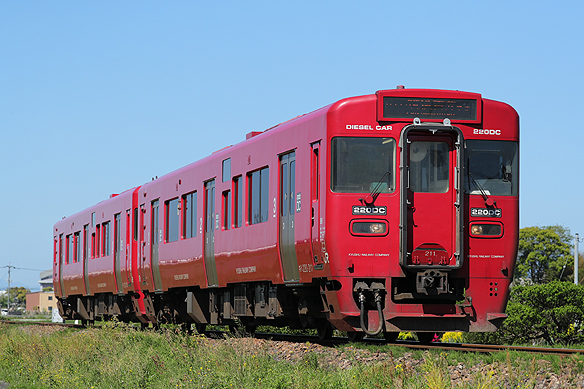Background and overview
JR Kyushu developed class kiha220-200 single-car diesel multiple unit (DMU) vehicles to replace superannuated kiha58 series vehicles with seating arranged as a mixture of longitudinal bench seating and flip-over transverse seating based on class kiha220-1500 with seating arranged as longitudinal bench seating throughout. 9 vehicles were delivered in 2006.
Car body
LED destination indicators fitted on the front and side of their body were enlarged in order to improve visibility. This change made the height of cab end section higher and the height of side windows below the destination indicator lower. Their floor level is made 20mm lower than former kiha200 series to eliminate the level difference between platforms and the floor for accessibility. The enlarged life guard device fitted under the cab end was introduced to improve the protection against obstacles at the level crossing. Blinds at the windows were discontinued by introducing heat ray absorption glasses. They employ a prime mover driven air conditioner, AU607KA, rated at 20,000kcal/h and a self-powered air conditioner, AU608KA, rated at 20,600kcal/h. Two indoor units are fitted on their roof and two outdoor units are fitted under their floor. No ventilator is fitted on their roof. They employed the tight lock coupler. The automatic jumper coupler is ready to be fitted.
Bogies
Class kiha220-200 vehicles are equipped with DT600KC for powered and TR600KA for trailer featuring bolster-less secondary air suspension and corn-shaped multilayered rubber spring journal supporting system. Their bogie employs bow-shaped bogie frame to lower the fitting position of bolster suspension due to lower the floor level for accessibility, and sealed and tapered roller bearings in order to improve ride comfort. The shock absorbing rubber for the support of final reduction gears was changed to improve shock-proof. Powered bogies employ single tread brake device and trailer bogies employ both single disk brake device and single tread brake device.
Traction unit and ancillary equipments
Class kiha220-200 vehicles are powered by one diesel prime mover, SA6D140HE-2
of Komatsu Ltd, with a power output of 450PS featuring the common rail
direct fuel injection for anti-air pollution and realizing the maximum
service speed at 110km/h. Their hydraulic transmission gears are DW14J,
featuring two-staged direct coupled range to improve the acceleration performance
and fuel consumption. kiha200 series feature the electric commanding brake
with holding brake by exhaust gas brake.
Accommodation
Passenger accommodation consists of a mixture of longitudinal bench seating
on one side and transverse seating bays on the opposite side to achieve
both easy boarding and alighting, and comfortability. A seat cushion and
a seat back of longitudinal bench seating is fitted separately for passengers
to recognize the seating space. High position seating is fitted where the
auxiliary water tank is located. Seat backs of the longitudinal bench seating,
the stool of the window, and the poster frame are made of fire-resistant
wood. A wheelchair space and a universal access toilet are located at toward
front of the vehicle. For conductor-less operation, they are equipped with
the ticket machine to issue the ticket indicating the boarding station
at the doorways and with the fare box near the driver's seat. The fare
box can be slided toward and stored inside the apparatus housing box to
retain the aisle to the gangway while using gangway located at the end
of the vehicle. Liquid crystal displays are fitted behind the cab and above
the centre door, providing train operation information by all displays
and a fare table by the ones located behind the cab.
Additional delivery
Additional three vehicles were delivered. They differ from former class kiha220-200 vehicles in having a flip-over spare seat for the helper at the wheelchair space, and a red LED flash light, which turns on while door opening/closing, above the doors.
Operations
Class kiha220-200 vehicles entered in 2006 and have been used on the rural services of Houhi and Kyudai lines. |
|

